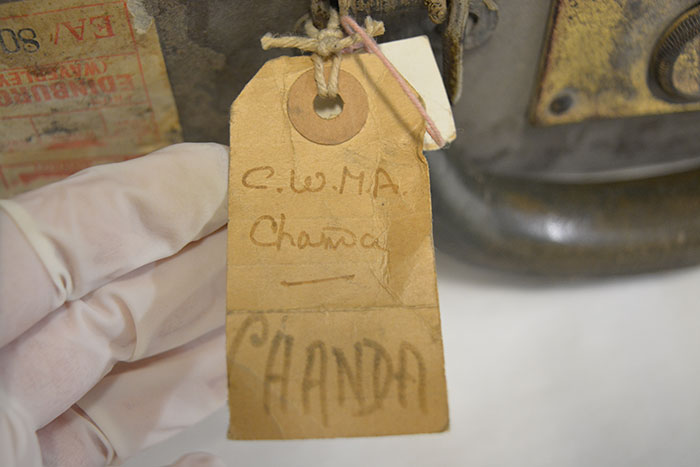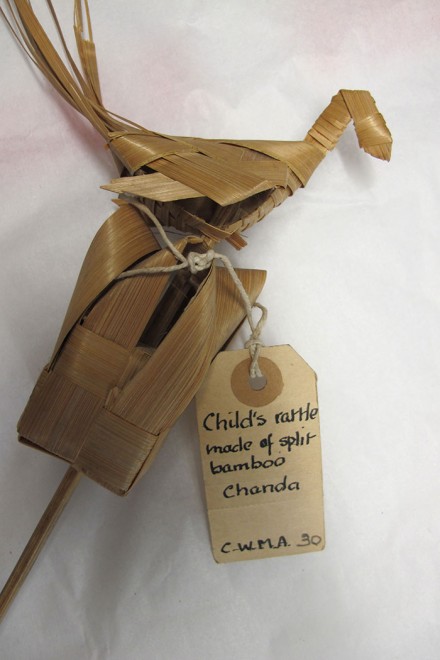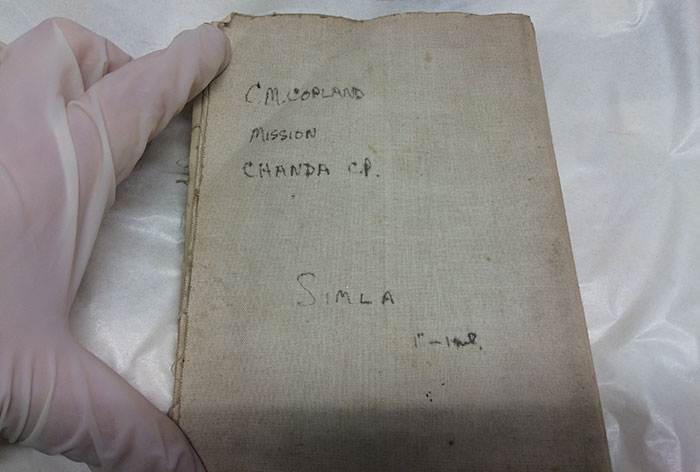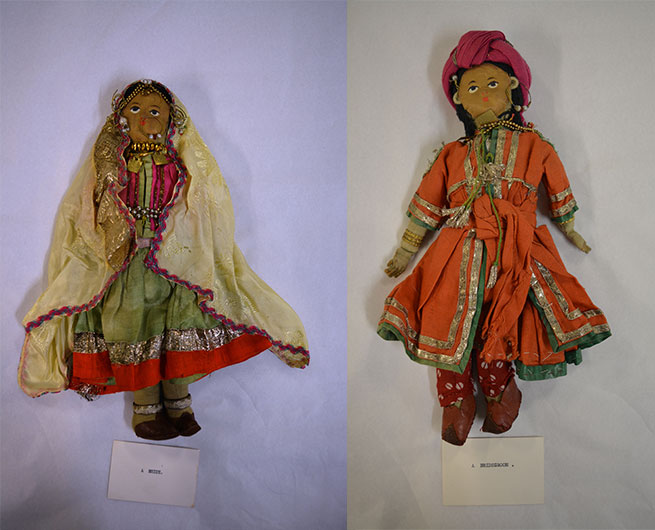Whilst carrying out some routine work in our stores, I came across an old luggage trunk with a label saying ‘Chanda Exhibits’ on it. It was packed full of a mixture of objects concealed in multiple layers of tissue paper. There was no additional information and for some reason a decision about acquisition had clearly not been made. Therefore, all I was left with to determine when these items came into the collection, why, and who they had come from, was a number of different labels attached to both the trunk and the objects inside.

The main label on the outside of the suitcase is addressed to ‘To Miss Todd Secretary C.W.M.A. / 13 Drumsheugh Gardens / Edinburgh from All Saints Church Aberdeen’. This has been scored out and ‘Chanda Exhibits’ written over the top, as well as on the side of the trunk. Miss Todd was secretary of the Church Women’s Missionary Association (CWMA) from 1923 until 1948, and the association had offices at the above address.
The CWMA is now known as the Scottish Episcopal Church Missionary Association (SECMA), and includes both men and women. Chanda, now Chandrapur in the state of Maharashtra, central India, was one of the two major missions for which the Scottish Episcopal Church was responsible from the 1870s onwards.


The objects inside the trunk ranged from a silk textile to shoes, jewellery and metal domestic utensils. Most of them had paper labels with ‘C.W.M.A’ handwritten on them, which confirmed the connection with the Church’s Women’s Missionary Association and that India was the provenance of these items.
It was at this moment that I also made a connection with a new research project at the University of Stirling entitled ‘Scottish Women On A Mission: a research project on Presbyterian and Episcopal women missionaries, 1918-1948’ (SWOAM) and led by Michael Marten, Alison Jasper and Rajalakshmi Nadadur Kannan, who have kindly helped us to find out more information.

We are still not entirely sure why or when this group of objects came into the museum, but there are a couple of additional clues inside the trunk. One is a handwritten sign saying ‘FR. Drage’s Treasures’. Reverend Leslie Henry Drage was Overseas Chaplain from 1964-1969. Elizabeth Marshall writes in her booklet produced for the 100th anniversary of CWMA:
…like the sun shining suddenly on a dreary day, the Reverend Leslie Drage was appointed to the new post of Overseas Chaplain. Perhaps he and his successor, the Reverend David Bruno, have done more than anyone else not only to stimulate new life and interest in Missions overseas, but also to restore confidence and enthusiasm to CWMA at home. The Overseas Chaplain became the personal link between congregation and the wider world no longer confined to Chanda and St. John’s but in New Guinea, Kenya, the Sudan, wherever our prayers and help are most needed. His annual visits to the branches opened a whole new world for CWMA. How, one wonders, did the Association manage without him? (A Pleasure and a Privilege, 1974, pp. 53-54).
So, one possible explanation is that this collection of objects was assembled by, or gifted to, Leslie Drage for illustrative purposes on his travels, and that they were given to the museum shortly after he died in 1969.

There is also a clue which points towards another key figure related to the mission at Chanda: ‘C. M. COPLAND / MISSION / CHANDA C.P. / SIMLA’ is handwritten on the reverse of a map of the Punjab. Charles McAlester Copland (1910-2009) was stationed in Chanda from 1938-1953, and was indeed head of the mission for a number of years, and published several books about his time in India.


Many of the labels on the objects have handwritten notes or explanations as to what the objects are, how they were used or who they were worn by, or where they were from. For example, the label on these two rattan discs, each painted with two red bands, reads: ‘India / Placed over the heads of a bride and bridegroom & water poured over them. / No marriage is complete without this ceremony.’
Finally, we come to a group of 17 Indian cloth dolls made with beautiful textile costumes and jewellery, which we have now been able to establish are also connected to the CWMA and the collection of objects in the trunk. A number of business cards were found with the dolls with ‘Mrs J. D. Bisset / The Rectory / Doune / Perthshire’ printed on them. On the back there are typed descriptions for some of the dolls, such as ‘bride’ or ‘bridegroom’.

Based on this, I looked up the name Bisset in Scottish Episcopal Clergy, 1689-2000, edited by David Bertie, and found that a John Davidson Bisset was in charge of St. Modoc’s Church in Doune from 1953-1966. He was born in 1896 and died on 21 April 1982 in Crail. He worked at the mission in Chanda from 1923-27 and in Bandikui (Rajasthan), both part of the Diocese of Nagpur, India, 1927-32. The name on the cards is that of his wife, Janet Bisset (d. 1956), who lived in India with her husband, and their four children. So it appears as though these dolls belonged to her, or perhaps were bought for the children.
We will continue to work on this collection by unpacking and officially registering the objects inside, and we are excited to find out more about them. Fortunately, there are lots of clues that have enabled us to build up quite a detailed picture so far, but there are still a few missing links. So if anyone has any related information please contact us. Likewise, Alison Jasper and Michael Marten from the SWOAM project are appealing for memories, objects or photographs related to Scottish women missionaries 1914 – 1948, whether at home or aboard. You can contact them here.
